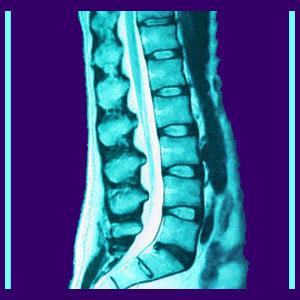
The ligamentum flavum (flava – plural) is one of the many spinal structures often implicated in contributing to back pain and neck pain conditions via the formation of central spinal stenosis. This anatomical term is usually found on spinal MRI reports, particularly those detailing a disc pathology concern. While the name of this structure is foreign to most patients, who do not understand the diagnostic findings on their reports, it is actually just the Latin words meaning yellow ligament.
This ligamentous structure exists in the rear of the spinal canal and often becomes inflamed and swollen due to several possible reasons. While ligament thickening is not usually a problem by itself, it can certainly contribute to a canal narrowing condition when other structural issues exist at the same hypertrophic level.
This essay explains the function of the yellow ligament and its role in creating problematic spinal canal narrowing.
Spinal Yellow Ligament
These ligaments link the lamina of each vertebral bone to one another, from the second cervical bone (axis) to the beginning of the fused sacrum (S1). The yellow ligaments are located inside the vertebrae, posterior to the central spinal canal and anterior of the spinous processes.
The yellow ligament is very difficult to see from an external view of the spine, but can be clearly seen from inside the spinal canal. The only time it is visualized is during dissection of a cadaver, during some forms of back surgery or virtually, via advanced diagnostic imaging, like magnetic resonance testing.
When ligament hypertrophy is discovered via diagnostic testing, it is often considered as a source of symptoms by the care provider. In some instances, this is wise, since the ligamentous changes can seal off the posterior of the canal completing a stenotic process when a herniated disc or osteophyte complex exists on the anterior side of the spinal cord. However, when hypertrophy exists alone, it is usually considered a nonissue.
Ligamentum Flava Study
The purpose of this yellow ligament is to bind the vertebral bones together forming a tight, but elastic fit to allow individual movement of the various spinal levels, while still providing incredible support for the spinal column.
This structure has become on of the many possible villains when it comes to sourcing back pain, since in some cases, thickening of the ligamentum flavum can cause or contribute to central spinal stenosis. Normally, thickening of the ligament is not a significant concern and is often seen asymptomatically in many, many patients. In these cases, pain blamed on the ligament thickening is surely a scapegoat condition. However, when there are other contributors to central spinal stenosis at the same level, the spinal cord may become compressed, leading to potentially serious health crises in rare instances.
Ligamentum Flavum Conclusions
This spinal ligament supports the vertebral area directly behind the spinal cord and cauda equina. It actually surrounds the rear of the central spinal canal. When the ligament thickens significantly in the presence of a severe herniated disc or osteoarthritic condition at the same level, stenosis can indeed result. In these cases, virtually the only cure is surgical intervention, although many patients can have their symptoms managed using less drastic modalities.
In most cases, the finding of ligament flava thickening is considered innocent on MRI reports and patients must be aware of this fact to avoid being placed into unnecessary care by opportunistic care providers who sense an easy payday.




